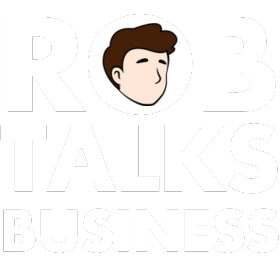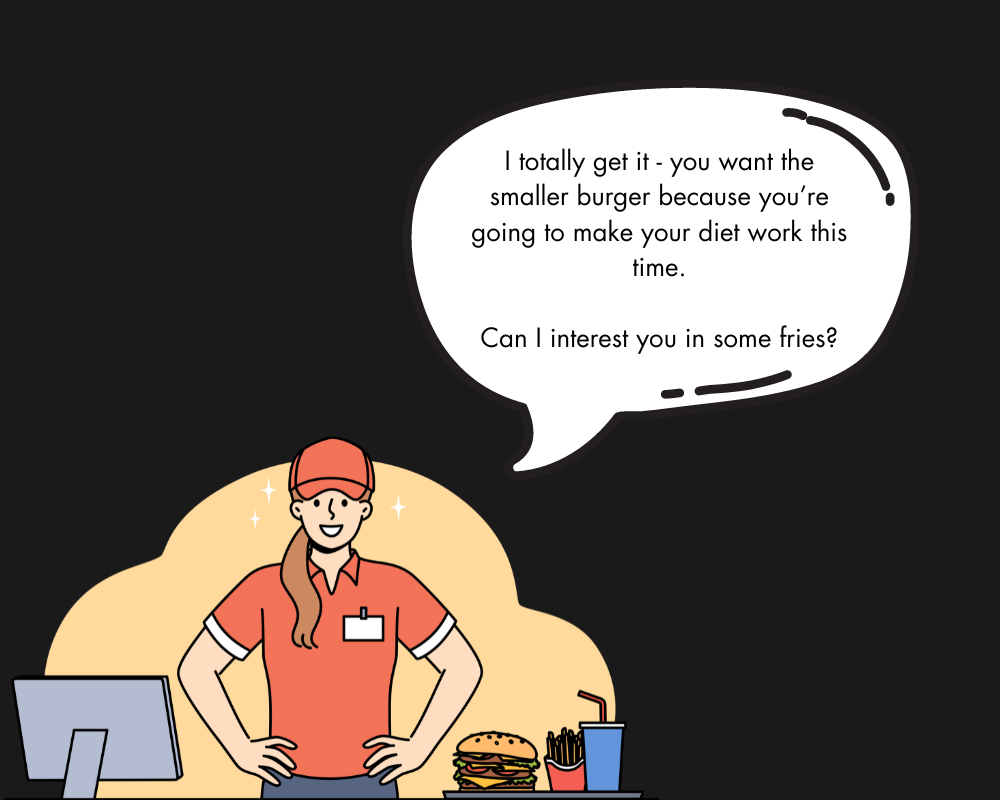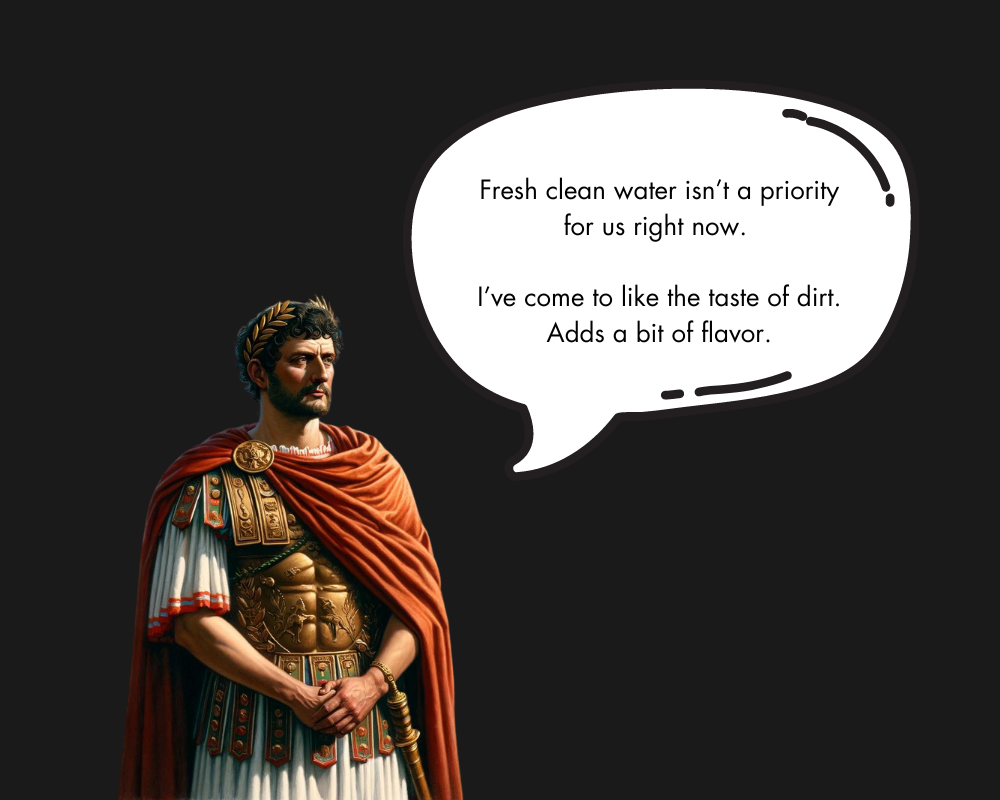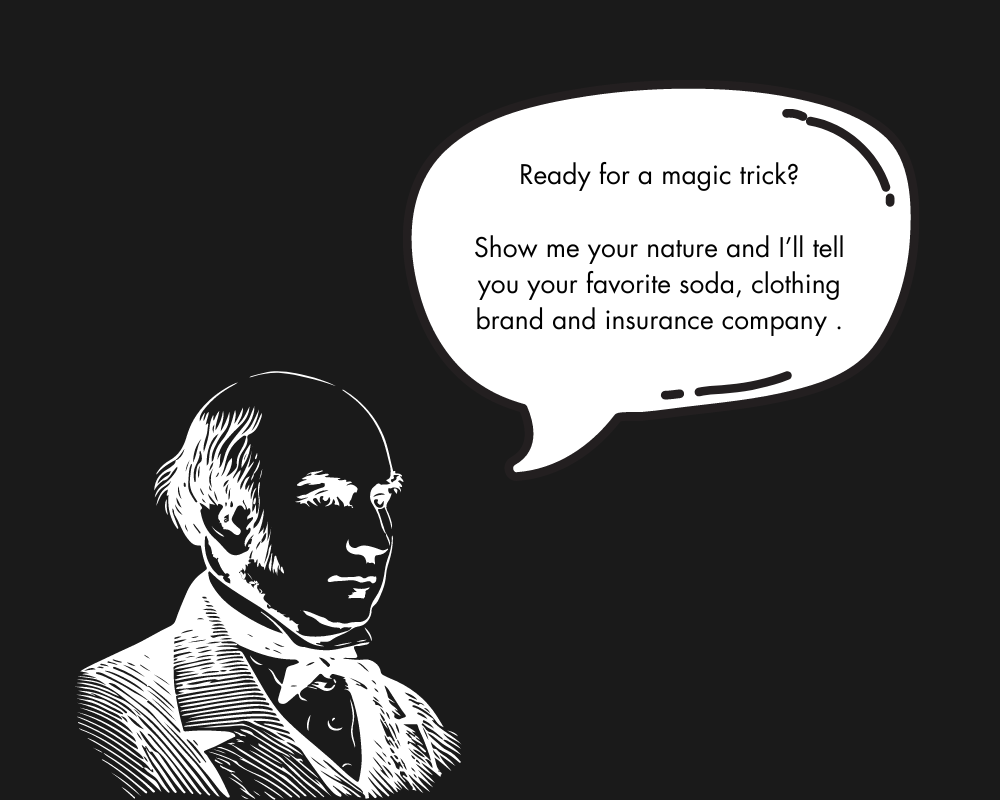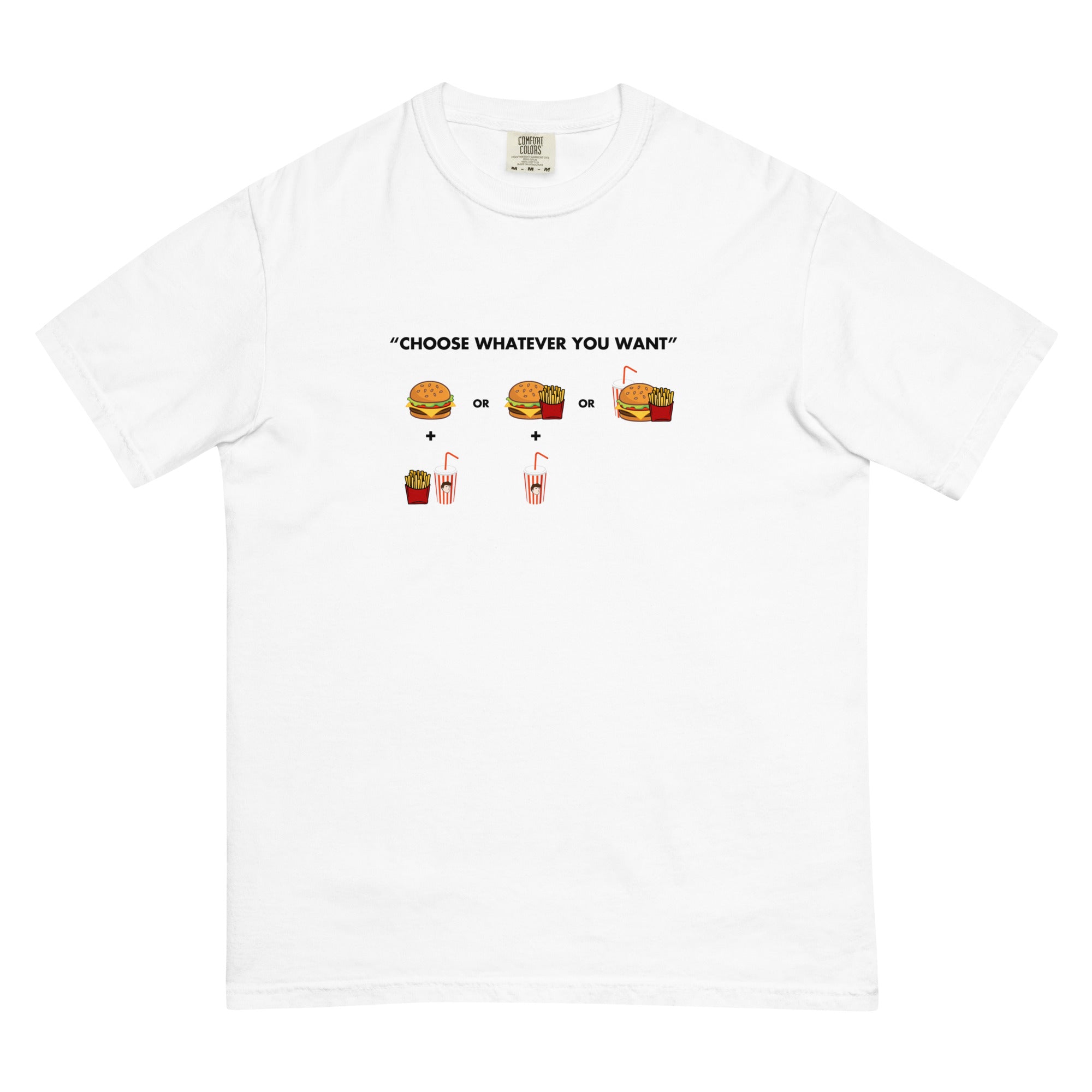"The greatest power is not to force others to make a choice, but to control the choices they have."- Niccolò Machiavelli
The modern consumer is assaulted by an endless array of choices.
Each decision - from selecting the right product to identifying with a brand’s values - becomes a source of mental fatigue. Faced with this overwhelming abundance, most become paralyzed, unable to act decisively.
Yet, beneath this surface confusion lies a fundamental truth: human beings crave the feeling of control.
Autonomy is not merely a luxury; it is an intrinsic need rooted deep in the psyche. It is not enough to present choices - what people truly desire is the illusion that they are in control of their decisions.
For the astute marketer, this presents a formidable challenge.
Too few choices, and you risk appearing rigid and uninspiring. Too many, and you drown your audience in indecision.
But therein lies the opportunity: if you can master the delicate art of offering the right amount of choice, you can subtly guide consumers toward decisions that serve your goals, all while allowing them to feel empowered, as if the outcome was entirely of their making.
This is where true mastery lies - in manipulating the perception of autonomy.
Understanding this psychological dynamic allows you to craft strategies that not only engage the consumer but also direct their actions with precision.
Maintain the appearance of freedom while controlling the path and you secure their loyalty without them ever feeling manipulated.
A War with the French
In the early 18th century, Europe found itself plunged into the chaos of the War of the Spanish Succession.
At the heart of this conflict was a struggle for dominance - who would succeed to the Spanish throne, and whether the balance of power in Europe would be dramatically altered.
The stakes were monumental.
France, under the ambitious Bourbon dynasty, sought to unite with Spain, creating an unstoppable force that could dominate the continent. Opposing them stood the Grand Alliance - a coalition of England, the Dutch Republic, Austria, and other powers - all determined to halt French expansion and maintain the fragile equilibrium in Europe.
France, in league with Bavaria, had the upper hand for much of the war. Their armies were vast, their victories numerous, and they now threatened to strike at the heart of the Austrian Empire.
The Grand Alliance entrusted their fate to John Churchill, the Duke of Marlborough, a commander of rare strategic brilliance. Marlborough was tasked with stopping a superior enemy and changing the course of the war, but the odds were stacked against him.
Marlborough’s Dilemma: The Power of a Superior Foe
By the summer of 1704, France and Bavaria had stationed a massive army along the Danube, poised to deliver a decisive blow to Vienna, the core of Austrian power.
Time was running out, and Marlborough knew that a direct assault on the French and Bavarian stronghold would be suicide - his forces were outnumbered, and a head-on attack would lead to certain failure.
Marlborough faced a dilemma: how to outmaneuver a stronger enemy without exposing his own weaknesses.
It was here that Marlborough revealed his genius, employing a tactic that echoes far beyond the battlefield into the realms of modern strategy and marketing: misdirection and the illusion of choice.
Rather than attack directly, Marlborough would manipulate his enemies into making fatal errors, all the while preserving their illusion of control.
The Setup: Misdirection and the Illusion of Choice
Marlborough devised a plan rooted in deception.
He marched his army toward Alsace, creating the impression that his forces intended to engage the French there. The French commander, Marshal Tallard, took the bait, diverting his attention and resources toward Alsace, believing Marlborough would challenge him on that front.
But Marlborough had no intention of attacking Alsace.
His real target was Blenheim, a village near the Danube, where the French and Bavarian armies had fortified their positions, confident in the strength of their defenses.
Marlborough knew he could not force a victory through strength alone, so he set about controlling the choices available to his enemy.
By feigning an attack on Alsace, Marlborough gave the French the illusion that they had options.
They could fortify Alsace, pursue Marlborough’s forces, or stay entrenched at Blenheim. Each choice appeared to hold promise, but in reality, Marlborough had stacked the deck - whichever path they chose would lead to their ruin.
The genius lay in the illusion of freedom.
The French commanders believed they were making strategic decisions, yet every option only furthered Marlborough’s objectives. The French chose to hold their ground at Blenheim, confident that Marlborough was too far away to threaten them.
The Battle of Blenheim: The Trap Closes
While the French rested in the false security of their position, Marlborough moved his forces swiftly across the Danube and into position near Blenheim, catching the French and Bavarians completely off guard.
They had believed they had controlled the situation, but Marlborough had set his trap long before they realized it.
The choices they thought were theirs to make had, in reality, been carefully constructed to funnel them into defeat.
On August 13, 1704, the Battle of Blenheim began.
The French and Bavarian forces, thinking they had the advantage, engaged Marlborough’s army, only to find themselves trapped and unprepared. Marlborough’s troops, strategically placed and masterfully commanded, decimated the enemy.
Over 30,000 French and Bavarian soldiers were killed or captured, and the once-dominant French alliance was shattered.
Marlborough’s victory did not come from brute force but from his ability to guide his opponents into making choices that, while appearing to serve their interests, had only served his.
The Lesson: Controlling Choices While Preserving the Illusion of Control
The Duke of Marlborough’s victory at Blenheim is a masterclass in the manipulation of choice.
He did not force his enemies into a single decision but gave them options that all led to their downfall. The brilliance lay in letting them believe they were in control, while Marlborough quietly dictated the terms.
This is the very essence of power - allowing others to think they are free while guiding them toward your desired outcome.
The parallels to modern marketing are clear.
Marketing Application: The Art of Curating Choices
Just as Marlborough gave his enemies the illusion of freedom while controlling the battlefield, marketers can present consumers with curated choices that create a sense of autonomy.
Too few choices and the consumer feels boxed in; too many, and they are overwhelmed.
The secret lies in striking the balance - offering enough options to make the consumer feel empowered, but ensuring that whichever path they choose, it serves your strategic interests.
Marlborough’s mastery of choice manipulation reflects a timeless truth: when people feel they are making their own decisions, they are far more likely to commit to them.
Whether in war or in business, true control lies not in forcing others into submission, but in guiding them down paths that appear to be of their own making.
In both strategy and marketing, it is not the brute force of persuasion that wins the day, but the subtle art of framing decisions - presenting the illusion of freedom while quietly steering others toward your desired outcome.
This is the key to long-lasting influence and success. Here’s how you can achieve it:
1. Curate Options to Guide Decisions
Limit the number of options to prevent indecision, but ensure that each choice serves your strategic goal. Just as Marlborough offered his enemies a series of paths, all leading to defeat, a brand should offer carefully curated product tiers - basic, standard, premium - each designed to serve the company’s interests while giving the consumer a sense of freedom.
Example: A software company might offer three pricing plans, framing the middle tier as the most popular. This subtle guidance nudges consumers toward the desired choice, increasing revenue while maintaining the illusion of personal decision-making.
2. Frame Choices to Highlight Benefits
Each option must appear to serve the consumer’s self-interest. Whether they select the least expensive or most premium option, the messaging should make them feel that every choice is a smart, rational decision. This is how you preserve the illusion of autonomy while ensuring their actions serve your objectives.
Example: Streaming services like Netflix and Spotify offer tiered subscriptions. Every choice - whether free, standard, or premium - meets specific needs, but no matter what the consumer chooses, the company benefits through higher engagement or revenue.
3. Guide Consumers Toward Your Desired Outcome
Like Marlborough’s brilliant feints, craft scenarios where consumers feel they are acting independently, unaware that their decisions have already been subtly guided toward your preferred outcome. Structure the options so that whichever path they choose, it serves your end.
Example: Apple offers different iPhone models - standard, Pro, and Pro Max. Regardless of which model the consumer selects, Apple achieves its goal: a sale. The consumer, meanwhile, feels empowered by the variety of options, unaware that the outcome has already been shaped in Apple’s favor.
Marlborough’s victory at Blenheim is a powerful reminder of the value of controlling choices. Just as he led his enemies into defeat by curating their perceived options, you, as a marketer, must stack the deck with paths that all lead to your desired outcome. Consumers, like Marlborough’s opponents, crave the feeling of control.
Give it to them - offer choices that empower them, but ensure that, in the end, all roads lead to victory for your brand.
By mastering this art, you shape the decision-making process while allowing the consumer to feel autonomous. This balance of subtle guidance and perceived freedom is the key to long-term influence and success.
A War with the French Fries
By the late 1970s, McDonald’s had secured its position as the unrivaled leader in the fast-food industry.
Its menu - precisely streamlined to offer burgers, fries, and milkshakes - dominated the market.
Simplicity was the key to its early success, driving efficiency and speed. Yet, as the years passed, the competitive landscape began to shift.
Consumer preferences evolved.
Rivals emerged, offering not just food but choices - larger portions, better value, and more variety. McDonald’s was faced with a challenge: how to maintain its streamlined efficiency while appealing to a market that now demanded more.
The Dilemma: Expanding Options Without Paralyzing the Consumer
McDonald’s found itself at a crossroads.
Consumers craved more options, but the danger of offering too many was real.
A vast menu could confuse or overwhelm the very customers they sought to serve. Too many choices lead to decision fatigue, a psychological state where people, paralyzed by too many options, fail to make any choice at all.
Too few options, on the other hand, would make McDonald’s seem inflexible, incapable of competing with the expanding menus of its rivals.
The solution McDonald’s devised was deceptively simple yet brilliant: the introduction of tiered meal sizes.
This strategy allowed the brand to present more options without overwhelming the consumer, maintaining control over the decision-making process.
The Strategy: The Power of Tiered Choices
In the 1980s, McDonald’s began experimenting with small, medium, and large meal sizes.
On the surface, this seemed like a response to customer demand for larger portions, but beneath this was a calculated strategy to manipulate consumer behavior. By curating three distinct choices, McDonald’s could shape the customer’s decision without appearing heavy-handed.
The Rule of Three: The Psychological Compromise
Human nature abhors extremes.
Psychological research reveals that when people are presented with three options, they instinctively gravitate toward the middle.
This is the compromise effect - the middle ground feels safe, balanced, and rational.
By offering small, medium, and large meal sizes, McDonald’s subtly funneled the majority of its customers toward the medium option.
Not too indulgent, not too frugal - just right.
McDonald’s engineered the middle choice to be the most attractive while upselling those who felt compelled to opt for the large size.
Stacking the Deck with “Yes” Options
Rather than forcing customers into a binary choice - buy or don’t buy - McDonald’s now presented three pathways, each leading to a purchase. Whether customers chose small, medium, or large, McDonald’s would win.
They had stacked the deck.
By offering multiple “yes” options, the company gave the illusion of autonomy while ensuring that whichever route the consumer took, it led to profit.
The Power of Perceived Value
The brilliance of McDonald’s strategy lay in how it framed the larger meal size.
The price difference between medium and large was minimal, but the psychological impact was enormous. By offering the large meal at a slightly higher price, customers felt they were getting better value - more food for only a little more money.
This encouraged many to spend more, driving up the average transaction value. The cost to McDonald’s of this upsell was negligible, but the boost in revenue was significant.
Testing and Success: The Measured Expansion of Choices
McDonald’s did not stumble upon this approach by accident.
They conducted extensive tests in various markets to gauge how consumers would respond to this tiered structure.
The results were clear: customers responded favorably to having a limited but well-defined range of choices.
The introduction of three options increased the likelihood that customers would upgrade to larger meals, especially when the perceived value of the upgrade was communicated effectively.
More importantly, the strategy simplified the decision-making process. Rather than being bogged down by an ever-expanding menu, customers could quickly select from three sizes, reinforcing McDonald’s reputation for speed and efficiency.
The brand maintained its operational simplicity while giving customers the sense that they were in control of their dining experience.
The Result: Increased Sales and Consumer Satisfaction
The tiered meal strategy was an undeniable success.
McDonald’s saw a sharp increase in sales and average order value following the rollout of small, medium, and large options. By offering more choices without overwhelming their customers, McDonald’s was able to capture a wider array of consumer preferences, from the budget-conscious to those seeking a larger portion.
What McDonald’s achieved was a delicate balance - simplicity and choice.
They avoided the pitfalls of offering too many options, which would have slowed service and confused consumers, and instead curated a controlled range of choices that empowered the customer while guiding them to spend more. The customer felt they were making the decision, but McDonald’s had shaped every step of that journey.
The Lesson: Control Through Curated Choices
McDonald’s strategy reveals an important truth: power lies in shaping the perception of choice.
By offering three clear options, McDonald’s allowed consumers to feel they were in control, all the while guiding them toward outcomes that served the brand’s interests.
This balance of autonomy and influence is the key to effective strategy - whether on the battlefield, in business, or in life.
Just as McDonald’s didn’t drown its customers in endless decisions, the astute strategist must understand the power of limitation. Curating choices allows you to channel others' decisions in your favor while maintaining the illusion of their freedom.
Stack the deck, give them “yes” options, and they will follow the path you’ve set - all the while believing it was their idea.
Marketing Application: Curating Choices to Control Consumer Behavior
McDonald’s mastery in shaping consumer decisions through its tiered meal strategy offers profound lessons for modern marketers.
The art lies in controlling the narrative of choice - offering just enough freedom to empower the consumer while guiding them precisely where you want them to go.
Here’s how to apply this in your marketing efforts:
1. Limit the Number of Choices
Too many options lead to paralysis. The wise strategist understands that fewer, well-curated choices are far more powerful than overwhelming abundance. Like McDonald’s three-tier system, offering three pricing or service tiers gives the illusion of variety while subtly steering consumers toward the middle ground - the option that balances value and profit.
Example: Spotify employs this strategy with its Free, Premium, and Family plans. The Free tier pulls in new users, but it is the Premium and Family plans - framed as upgrades - that truly serve the company’s long-term goals.
2. Create “Yes” Options
Never offer your audience a simple yes-or-no decision. Instead, present multiple paths that all lead to the same outcome - your desired one. Just as McDonald’s tiered meals all end in a purchase, you should structure your offerings so that each option benefits your brand.
Example: Amazon employs this brilliantly with its multiple payment options at checkout (credit card, PayPal, Buy Now, Pay Later). No matter the path chosen, the end is the same - a completed purchase.
3. Highlight Value in the Middle Option
In any tiered system, the middle option is where you concentrate your power. Like McDonald’s medium-sized meal, the middle choice should be framed as the most rational, the best value. Consumers, uncomfortable with extremes, will naturally gravitate toward it.
Example: Slack uses this tactic in its pricing plans, positioning the middle tier as the “most popular” option - offering a balance of features and price, it becomes the most appealing and profitable choice for businesses.
4. Use Pricing to Encourage Upsells
The subtle art of incremental pricing is a masterstroke in guiding consumer behavior. By offering a minimal price difference between tiers, you make upgrading feel like an easy, almost necessary, decision. The consumer feels they are getting more value for slightly more cost, while you extract higher revenue.
Example: Movie theaters are experts at this. They offer small, medium, and large sizes for drinks or popcorn, with a marginal price difference between medium and large. The customer almost always chooses the larger size, believing they’re getting a better deal.
McDonald’s tiered meal strategy is not merely a marketing tactic - it is a masterclass in choice architecture. The power lies in offering the consumer a controlled selection - just enough to give the illusion of freedom but structured to serve your interests.
In marketing, the lesson is clear: less is more.
By simplifying the range of options, framing them carefully, and emphasizing the value of your middle ground, you guide the consumer toward decisions that benefit both them and your brand. This delicate balance of autonomy and control, this illusion of choice, is the key to long-term influence and loyalty.
To lead your audience, give them choices.
But remember: the true power lies not in the choice itself, but in how you shape it.
The Illusion of Choice: Why It Holds Power
At the core of human psychology is a fundamental need for autonomy.
We are wired to crave the feeling that we control our destiny, that our decisions are made freely and without coercion. Countless studies confirm that people derive far greater satisfaction when they believe their choices are their own - even when those choices are, in truth, limited or carefully structured.
In the realm of marketing, this truth is invaluable.
By offering consumers a range of choices, you allow them to preserve the illusion of freedom, all the while guiding them toward your desired outcome.
The danger of presenting a single option is that it forces the consumer into a binary, yes-or-no decision - one that feels rigid, like an ultimatum.
Such stark choices often breed resistance, as no one likes to feel backed into a corner. The key to successful persuasion, then, lies in offering multiple paths, each of which ultimately leads to the same end: your goal.
The consumer, believing they have exercised control, moves forward without sensing they were subtly guided all along.
The Balance of Freedom and Control
The true brilliance of the illusion of choice lies in its ability to balance apparent freedom with invisible direction.
You must make your audience feel as though they are in command, that they are making empowered decisions. Yet, beneath the surface, you are carefully orchestrating the choices they are presented, ensuring that every option aligns with your objectives.
This delicate interplay between autonomy and control is where real mastery lies. When executed with skill, it not only satisfies the consumer's psychological need for independence but also serves your strategic interests.
The challenge, however, is ensuring that the consumer never feels manipulated. If the illusion is broken, if they sense the guiding hand too clearly, trust dissolves, and they will rebel against the very options you have laid out.
The art is in crafting choices that genuinely seem beneficial to the consumer, even as they lead toward the outcome that benefits you most.
Done correctly, the illusion of choice becomes a powerful tool - a subtle yet potent blend of freedom and influence that allows you to guide without force, and control without constraint.
The Reverse: How to Avoid the Trap of Choice Paralysis
While offering choices is a powerful strategy, one must never fall into the trap of overwhelming the consumer.
Too many options paralyze the mind, creating a sense of anxiety and indecision.
This is the paradox of choice, a concept popularized by Barry Schwartz, who observed that while more choices seem enticing, they often lead to dissatisfaction and inaction.
The more paths we are presented with, the harder it becomes to make a decision, and often, no decision is made at all.
To avoid this pitfall and maintain control over your audience’s choices, you must offer enough to give them a sense of freedom while subtly guiding them to the outcome you desire. Here is how to prevent choice paralysis:
1. Limit the Number of Options
When the field is too wide, decisions are delayed or abandoned.
The mind craves simplicity, and by offering fewer, more curated choices, you simplify the decision-making process.
Consider Procter & Gamble and their Head & Shoulders line: When they reduced their product range from 26 versions to 15, they saw a 10% increase in sales. By eliminating unnecessary options, they made the decision easier, leading to greater conversions.
2. Harness the Power of Three
There is an elegant power in the number three.
It presents enough variety to satisfy the need for choice, but not so much that the consumer feels overwhelmed.
McDonald’s perfected this strategy with its small, medium, and large meal sizes, guiding the consumer without drowning them in possibilities. Offer three distinct tiers - basic, standard, and premium - and you will see your audience gravitate toward the middle, feeling they’ve made a rational choice.
3. Guide with Defaults and Recommendations
When the burden of choice weighs too heavily, the clever strategist provides a gentle push. By offering a default option or highlighting a recommended choice, you ease the consumer’s path.
Spotify does this masterfully with its “Discover Weekly” playlist, reducing the need for users to search endlessly.
Similarly, Amazon nudges its customers with “Best Sellers” and “Customers Also Bought,” guiding them without force. This subtle steering builds trust and simplifies the decision-making process.
4. Prioritize Quality Over Quantity
Instead of drowning your audience in a sea of similar products, focus on a few that are of high quality and well-differentiated.
Apple has perfected this approach. Rather than offering dozens of iPhone models, they release only a select few - each carefully designed to appeal to different customer needs. This precision keeps the decision process simple and prevents overwhelm, while still catering to a variety of preferences.
5. Categorize Choices Clearly
When options are too numerous, categorization becomes a powerful tool. Break choices into clear, digestible categories, and you offer the mind a sense of order.
Netflix employs this tactic with precision, organizing its thousands of shows into categories like “Trending Now,” “Top Picks for You,” and “New Releases.” By framing choices within easily understood boundaries, you reduce the sensation of being overwhelmed, making selection intuitive and manageable.
6. Simplify the Path to Purchase
The more steps required to complete a decision, the greater the risk of abandonment.
A streamlined, frictionless journey from consideration to purchase is essential.
Amazon's "Buy Now with One Click” feature is a prime example of this principle in action. By removing unnecessary steps, they simplify the decision and reduce the chance of second-guessing, allowing consumers to finalize their purchases swiftly and with confidence.
The Takeaway: Clarity Over Complexity
In the art of persuasion, the balance between offering choices and maintaining simplicity is delicate but crucial.
While consumers desire autonomy, too many options overwhelm them, leading to indecision.
The solution lies in curating choices, using the rule of three, guiding decisions with subtle defaults, and ensuring the journey to purchase is free of unnecessary distractions.
When you strip away the complexity and direct your audience toward clear, relevant choices, you empower them.
They will make decisions faster, feel more satisfied with their choice, and ultimately, you will gain their loyalty.
Remember: control does not lie in offering endless possibilities, but in presenting just enough to make the decision feel effortless and inevitable.

